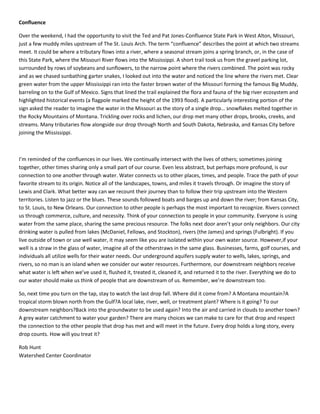
Missouri and Mississippi Rivers Confluence State Park
- 1. Confluence Over the weekend, I had the opportunity to visit the Ted and Pat Jones-Confluence State Park in West Alton, Missouri, just a few muddy miles upstream of The St. Louis Arch. The term “confluence” describes the point at which two streams meet. It could be where a tributary flows into a river, where a seasonal stream joins a spring branch, or, in the case of this State Park, where the Missouri River flows into the Mississippi. A short trail took us from the gravel parking lot, surrounded by rows of soybeans and sunflowers, to the narrow point where the rivers combined. The point was rocky and as we chased sunbathing garter snakes, I looked out into the water and noticed the line where the rivers met. Clear green water from the upper Mississippi ran into the faster brown water of the Missouri forming the famous Big Muddy, barreling on to the Gulf of Mexico. Signs that lined the trail explained the flora and fauna of the big river ecosystem and highlighted historical events (a flagpole marked the height of the 1993 flood). A particularly interesting portion of the sign asked the reader to imagine the water in the Missouri as the story of a single drop… snowflakes melted together in the Rocky Mountains of Montana. Trickling over rocks and lichen, our drop met many other drops, brooks, creeks, and streams. Many tributaries flow alongside our drop through North and South Dakota, Nebraska, and Kansas City before joining the Mississippi. I’m reminded of the confluences in our lives. We continually intersect with the lives of others; sometimes joining together, other times sharing only a small part of our course. Even less abstract, but perhaps more profound, is our connection to one another through water. Water connects us to other places, times, and people. Trace the path of your favorite stream to its origin. Notice all of the landscapes, towns, and miles it travels through. Or imagine the story of Lewis and Clark. What better way can we recount their journey than to follow their trip upstream into the Western territories. Listen to jazz or the blues. These sounds followed boats and barges up and down the river; from Kansas City, to St. Louis, to New Orleans. Our connection to other people is perhaps the most important to recognize. Rivers connect us through commerce, culture, and necessity. Think of your connection to people in your community. Everyone is using water from the same place, sharing the same precious resource. The folks next door aren’t your only neighbors. Our city drinking water is pulled from lakes (McDaniel, Fellows, and Stockton), rivers (the James) and springs (Fulbright). If you live outside of town or use well water, it may seem like you are isolated within your own water source. However,if your well is a straw in the glass of water, imagine all of the otherstraws in the same glass. Businesses, farms, golf courses, and individuals all utilize wells for their water needs. Our underground aquifers supply water to wells, lakes, springs, and rivers, so no man is an island when we consider our water resources. Furthermore, our downstream neighbors receive what water is left when we’ve used it, flushed it, treated it, cleaned it, and returned it to the river. Everything we do to our water should make us think of people that are downstream of us. Remember, we’re downstream too. So, next time you turn on the tap, stay to watch the last drop fall. Where did it come from? A Montana mountain?A tropical storm blown north from the Gulf?A local lake, river, well, or treatment plant? Where is it going? To our downstream neighbors?Back into the groundwater to be used again? Into the air and carried in clouds to another town? A grey water catchment to water your garden? There are many choices we can make to care for that drop and respect the connection to the other people that drop has met and will meet in the future. Every drop holds a long story, every drop counts. How will you treat it? Rob Hunt Watershed Center Coordinator